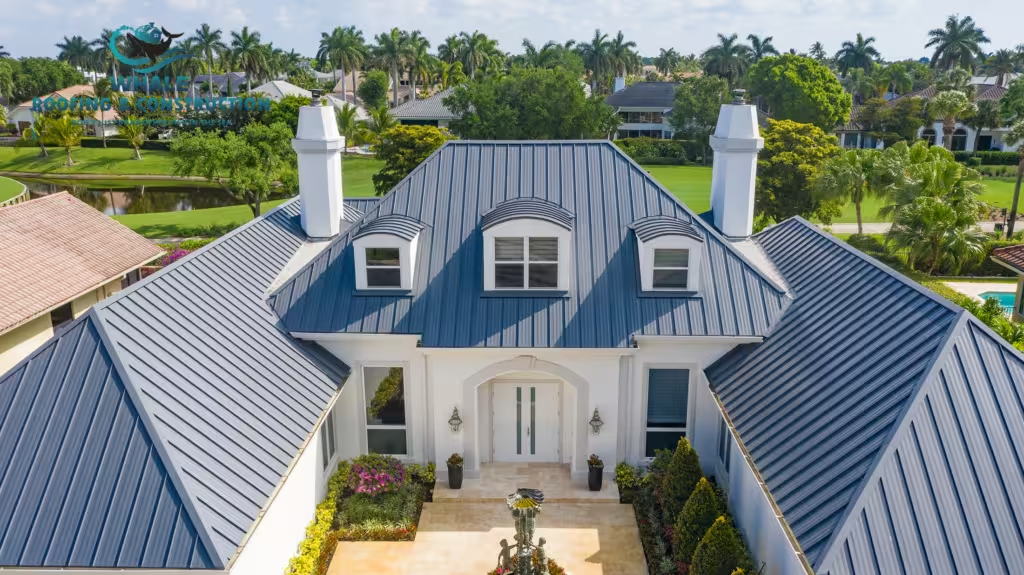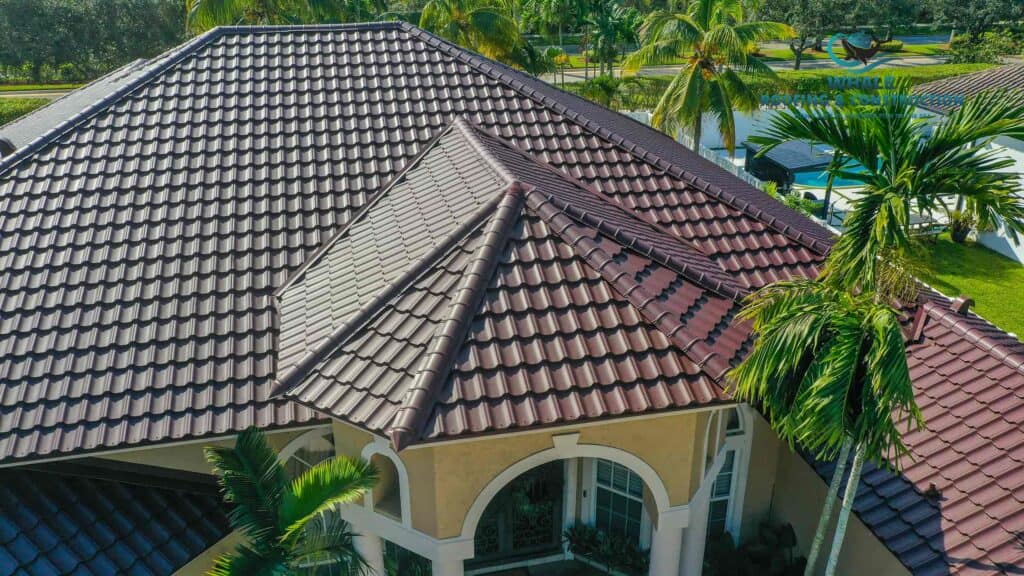Small cracks in your roof’s flashing might seem minor, but they can turn into major problems during storm damage inspections.
Storms wreak havoc on roofs. They loosen, crack, or completely tear off shingles which causes leaks and make things worse if you don’t fix them right away. Most homeowners realize they have a problem only when water starts dripping through their ceiling.
Your home needs a full storm damage roof inspection to spot these issues before repairs get pricey. Smart homeowners in South Florida should know how to check for wind damage. This includes looking from the ground with binoculars or getting professional help. On top of that, it helps to document your roof’s condition when you file insurance claims after bad weather.
Whale Roofing knows exactly what South Florida storms can do to your home. We stand as Boca Raton’s most trusted roofing company, ready to help you handle storm damage and protect your valuable investment. Our professional roof storm damage inspections will keep your home safe and secure through any weather.
Start With A Safe And Thorough Roof Inspection
Your safety comes first when you check your roof for storm damage. A proper assessment of damage after bad weather can help you avoid thousands in unnecessary repairs.
How To Inspect A Roof For Wind Damage
Strong winds can really do a number on your roofing system. You should look for missing, lifted, or creased shingles that clearly show wind damage. Take a walk around your property to spot any shingles that might have blown into your yard. The edges of your roof need extra attention because wind can easily lift them up.
Your roof vents, flashing around chimneys, and other protruding parts need a close look since wind can loosen them. Pay attention to subtle signs like lifted shingle edges – they might not jump out at you right away but could let water seep in during the next storm.
What To Check From The Ground
You can spot many problems from ground level without putting yourself at risk:
- Look for dents, sagging, or loose gutters and downspouts
- Check for granules (small, gravel-like particles) near downspouts or in gutters that suggest your shingles are wearing down
- Watch for water stains on exterior walls that point to drainage issues
- Keep an eye out for roof debris that could trap moisture and cause damage
The team at Whale Roofing suggests you walk around your house after any major storm. You should also check your attic for leak signs like wet insulation, water spots, or sunlight peeking through the roof boards.
Using Binoculars Or Drones Safely
Binoculars offer a safer way to look at your roof than climbing up there. Stand firmly on the ground and use them to get a good look at your roof’s surface. This helps you spot damaged flashing, curled shingles, or other issues you might miss otherwise.
Drones have changed the game for storm damage inspections. These devices take detailed pictures of your entire roof in minutes without any safety risks. That’s why we at Whale Roofing use professional-grade drones to provide complete storm damage roof inspection services in South Florida.
Stay safe and let our team at Whale Roofing handle the professional assessment instead of risking roof access yourself. As Boca Raton’s most trusted roofing professionals, we give you a full picture of any storm damage. Quick action on small problems helps you avoid big repair bills later.

Documenting Storm Damage For Insurance Claims
Good documentation is your best friend when filing insurance claims for roof damage. The proof you gather after a storm can separate a quick approval from a frustrating denial.
Take Clear Photos Before And After
Photos with timestamps give solid proof of damage timing and are a great way to get insurance approval. Insurance companies need visual evidence to review claims. Here’s what you should do:
- Get wide-angle shots of your whole roof and zoom in on damaged spots
- Take pictures from several angles to show all the damage
- Shoot photos in daylight to get the clearest views
- Show any indoor damage like water marks or ceiling drips from roof problems
- Add date and time stamps to your pictures if you can
Our storm damage inspection teams at Whale Roofing use top-quality gear to document your roof’s condition and give you detailed evidence to support your claim.
Keep A Record Of Previous Repairs
Your roof’s repair history shows you’re a responsible homeowner. These documents make your case stronger when you file claims after storm damage. These records also help separate old issues from new storm damage.
Keep all your receipts, inspection reports, and maintenance records in a “roof file” that you can grab quickly.
Why Documentation Speeds Up Claims
Good documentation speeds up your insurance claim by a lot. Our experience shows that claims with clear visual proof and detailed records get processed faster than those without proper documentation.
The right documentation cuts down on extra investigations and back-and-forth with your insurance company. Adjusters can make quick decisions when they see exactly what caused the damage.
Our team at Whale Roofing knows South Florida’s storm challenges inside out. We do full storm damage roof inspections and help you document everything you need to win your insurance claim. Reach out to us today if you need help with storm damage documentation.
Know What To Do If You Have Storm Damage
Storm damage on your roof demands quick action. Quick repairs can stop small problems from turning into major structural headaches that get pricey.
Temporary Fixes To Prevent Further Damage
You must stop active leaks right after a storm to limit damage inside your home.
- Clean and dry the area before applying roofing cement or sealant to small cracks
- Use strong plastic tarps to cover damaged areas and secure them well to block water
- Set up buckets under leaks inside your house to catch water
- Remove debris from gutters and roof surfaces that could hold moisture
These quick fixes serve as emergency solutions until professional help arrives. Whale Roofing’s emergency tarping services protect your home from water damage while you wait for permanent repairs.
Contacting A Licensed Roofer In South Florida
Local professionals deliver quality repairs, unlike “storm chasers” who show up after bad weather. Whale Roofing, a 15-year old roofing company in Boca Raton, offers detailed storm damage inspections and repairs across South Florida.
Licensed professionals bring essential benefits:
- Expert assessment of damage extent
- Complete documentation for insurance claims
- Quality repairs that last
- Help to direct you through insurance claims
Understanding Your Homeowner’s Insurance Coverage
Your homeowner’s insurance usually covers roof damage from storms or hurricanes, but policies differ. Check your policy to know what’s covered and whether you have Actual Cash Value (ACV) or Replacement Cost Value (RCV) coverage.
ACV policies pay only your roof’s depreciated value when you claim. RCV policies cover the cost of a new roof. Call your insurance company right after you spot damage. Most insurers give you 1–2 years to file claims after a storm.
Whale Roofing works with insurance companies to help you get your policy’s full benefits. Our storm damage roof inspections give you the documentation needed for a successful claim.

Long-Term Roof Protection Strategies
Your best defense against future storm damage starts with taking action now. These strategies will make your roof stronger and better prepared for South Florida’s harsh weather.
Install Impact-Resistant Shingles
Class 4 impact-resistant shingles shield your home better from hail and wind-driven debris. These premium materials contain polymer-modified asphalt that stays flexible during impacts. This flexibility prevents cracks and keeps granules in place. Homeowners who choose Class 4 shingles can save 5% to 35% each year on insurance premiums.
Whale Roofing recommends impact-resistant shingles that feature reinforced nailing zones and strong adhesive strips. These strips lock shingles firmly in position. The materials can handle winds up to 130 mph – enough to withstand a Category 4 hurricane.
Improve Attic Ventilation And Insulation
Good attic ventilation combined with proper insulation helps your roof last longer by:
- Stopping moisture that causes mold and structural damage
- Keeping temperature steady to protect roofing materials
- Cutting energy costs by 25–50% compared to poorly insulated attics
The best ventilation system needs balanced intake vents (soffit vents) and exhaust vents (ridge vents). We use a 1:300 ratio – one square foot of ventilation for every 300 square feet of attic space. Whale Roofing’s team can look at your current setup and suggest improvements that work best for your home.
Schedule Seasonal Roof Storm Damage Inspections
Professional inspections twice a year – spring and fall – help catch small problems early. These checks become even more crucial after major storms hit.
Whale Roofing’s storm damage specialists use professional equipment to check every part of your roof system. We spot subtle warning signs that untrained eyes might miss. Our detailed documentation serves as a great way to get both maintenance plans and insurance claims handled properly.
Call Whale Roofing today to book your professional roof inspection or learn more about our storm-resistant roofing options for South Florida homes.
Protect Your Roof, Protect Your Home — Call The Experts At Whale Roofing
Storm damage isn’t always obvious—but the costs of ignoring it can be huge. At Whale Roofing, we specialize in thorough storm damage inspections, detailed documentation for insurance claims, and expert repairs that stand up to South Florida’s toughest weather. Whether you’re dealing with visible damage or just want peace of mind after a major storm, our Boca Raton-based team is here to help.
Don’t risk costly repairs down the line. Contact Whale Roofing today to schedule your professional roof inspection and see why we’re the most trusted name in South Florida roofing.